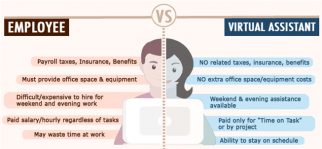There seems to be a lot of debate on the subject that employee costs are far more effective for the business bottom line rather than the use of a Virtual Assistant.
If you currently have an employee, or in many instances, more than one employee in your office, for on average, 8 hours each day, Monday – Friday, that becomes a 40 hour working week inclusive of lunch breaks. It’s interesting to consider, as an employer, just what you are getting for your money; ‘time paid’ v’s ‘productivity’.
Let’s look at wasted/’dead’ time that occurs in the working day:
- Potential cigarette breaks
- Toilet breaks
- Late arrivals into the office
- Leaving early
- Checking personal social media
- Talking on the phone to friends or family
Then in addition the company benefits you are also liable for:
- Sick pay
- Holiday pay
- Pension scheme
- Childcare vouchers
- Uniforms
- Company car
- Healthcare scheme
There is also the added employee costs from being based in the office:
- Desk space
- Stationary
- Office equipment
- Phone line and/or mobile
- Kitchen facilities
An overview of a Virtual Assistant (VA)
If you are interested as to how you can work with a Virtual Assistant, here is a little in-sight for you.
You would start by having a consultation with your chosen VA (normally complimentary and at a time that is mutually convenient). Once the services that are to be undertaken and the hours have been agreed you will receive a contract from your VA to include a non-disclosure agreement to ensure your business ‘goings on ‘ remain confidential, Then once your VA receives your signed contract back you will start to communicate with your VA via the method that works best for you eg Skype, calls, text’s, e-mail, in order to relay information about the work you wish to be carried out, this may be weekly or daily.
Your VA will clock the time used (usually on a system that produces time-sheets) for each task undertaken from their own place of work. Sometimes a VA is happy to come to your place of work but this would be by prior arrangement only and will also largely depend on the VA’s own set of circumstances and commitments. Remember they are Virtual, the choice is ultimately down to the individual.
Virtual Assistant Costs
You will never need to pay any of the costs mentioned above for use of a VA. If he/she has extra costs such as postage etc, then yes, this will be added to your invoice but you will only ever pay essential costs.
Comparable Costs
A saving right there of £18,200!! What business wouldn’t want to save those costs?
So by taking a look at the pro’s and con’s of both an employee and VA it seems obvious that employee costs are far higher and less productive, we need to step away from this age old mentality of needing to have someone on site full-time or part-time. Certainly there are jobs that this isn’t an option for but on the whole when you consider the tasks Virtual Assistants can undertake many companies could learn to make the shift. It seems to the business of the 21st Century with many making the leap from employee to VA.
If you are considering either a re-structure, hiring a new member of staff or simply would like to find out about the possibility of utilising a VA then click on the link to schedule your free 30 minute consultation with absolutely no obligation to proceed – https://praemando.10to8.com
We hope you have found this information useful in how your business could make savings and boost productivity.
Have a great week.
Lindsay x


